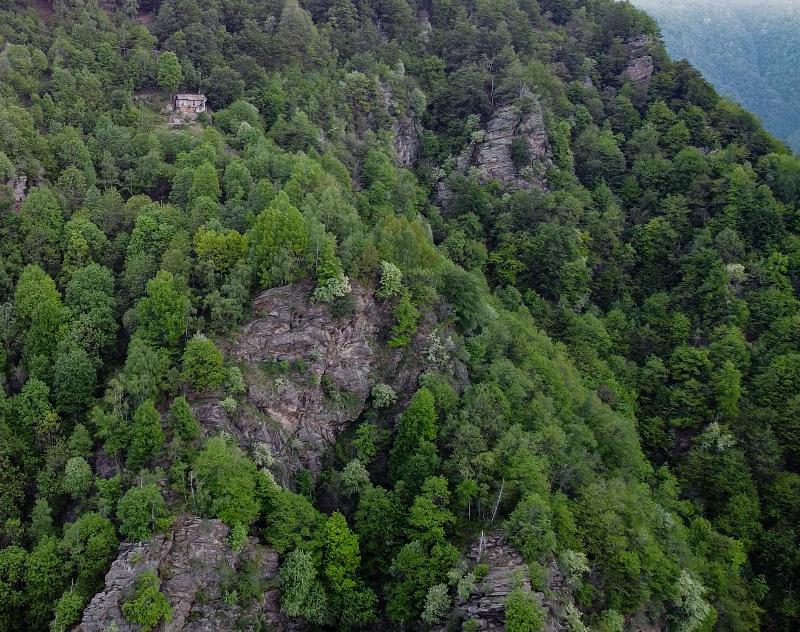Late frosts can be real bummer. They ARE a real bummer. They were an absolutely real bummer last night in my garden. :-(
So I'm bummed.
My particular Problem:
My place is beautiful and up in the mountains. I'm at 4000ft, south-sout-eastern slope @ 30° incline (66%, so pretty steep). It is certainly not prime garden territory but I do what I can and select the plants that work for my zone - which is 7 (I have years that stay well within 8 and true laurel - zone 8 - grows big both against stone walls and free standing in the garden (for 20 years or more now). In fact overall temps are pretty benign in my micro climate during winter, but there is one thing that is bound to ruin things: late frost. It is worsened by the fact that at my incline the ground stands at a better angle even towards the winter sun and thus heats up quicker. On the slope there is no cold sink and I'm usually snow free after a few sunny days. I might have weeks on end of pure sunshine and above freezing temps in February and March. So things just start sprouting and growing. April and sometimes even May weather may turn for a few days. Cold air sent by the Russians hits Europe and the Alps. Last night it hit 24 F
Here is an image of the house and property (in May), though the garden below the house is not very visible in that pic:
Late Frost - Solutions for fruit bearing trees and bushes?
There are some solutions I'm aware of:
- making it rain on the plants as long as the temps are below freezing to use the heat that is generated in the process of freezing - sounds strange but that is physics and done on big plantations where there is such a risk (not feasable in my case)
- heating with torches (not feasable - also because heat travels up the hill and does not stay near the trees)
- putting garden fleece out there (works form some smaller things but not for big things)
- people (agrarean scientists - mostly in vinyards) have experimented with spraying a 10% vegetable oil solution in spring before the buds form which appears to delay things anywhere from 2-40 days depending on the weather and other factors in the case of wine. (can be a problem for plants that need the longest possible growing season - including wine that might need those sun hours to produce sugar - but it may work for other things. Research is still being done.)
Other Ideas?
Has anyone experimented with other methods to delay leafs/blooming?
- There is the advice sometimes given to put early flowering plants that are at rist, like apricots, on the north side where it stays cooler longer. That can work for some. My land however is entirely on the southern slope.
- terracing. Terraces improve not only water retention but their level surface also decreases the angle to the winter/spring sun, thus the ground does not warm up as quickly. Snow stays visibly longer which proofs the point. One point with stone terracing though - as in my case - the stone wall retains heat which is great in cool summer nights and it protects from cool winds but that of course counters the desired delay of the ground warming up in the spring as well.
- mulching? Can mulch in a certain thickness isolate not only the ground against freezing but also from warming up too much? Anyone have experience with that?
- shading? When I look at the northern slope that I face it naturally stays cooler much longer. Snow covers the ground there when I pick the first flowers.. Since I can only plant on the south side, would it maybe be an option to construct artificial removable shade (from willow branches - woven like a willow basket - or with poles and fleece for example) and place that like a "wall" in front of the sensitive trees. It would place them artificially for a month or two onto "the north side" (of the wall) and prevent the ground from warming up - and thus delay blooming.





 that must look cool. I wonder though at which point a heating cable becomes more efficient. There are 30ft long cables consuming 100W which would equal to a single 100W bulb. Seems a more efficient way with lower running costs (though an investment) if the goal is not light but just heat.
that must look cool. I wonder though at which point a heating cable becomes more efficient. There are 30ft long cables consuming 100W which would equal to a single 100W bulb. Seems a more efficient way with lower running costs (though an investment) if the goal is not light but just heat.






 . It shows in the garden, as for example I have a 25 year old laurus nobilis (bay laurel) that is usually given a usda rating of 8-11. It sits against a wall so benefits from a micro climate and I need to prune the top regularly to keep it under 15ft (otherwise it would throw shade on my solar panel on the terrace above). But it's younger cousin (10 years) is doing just fine free standing unprotected.
. It shows in the garden, as for example I have a 25 year old laurus nobilis (bay laurel) that is usually given a usda rating of 8-11. It sits against a wall so benefits from a micro climate and I need to prune the top regularly to keep it under 15ft (otherwise it would throw shade on my solar panel on the terrace above). But it's younger cousin (10 years) is doing just fine free standing unprotected.